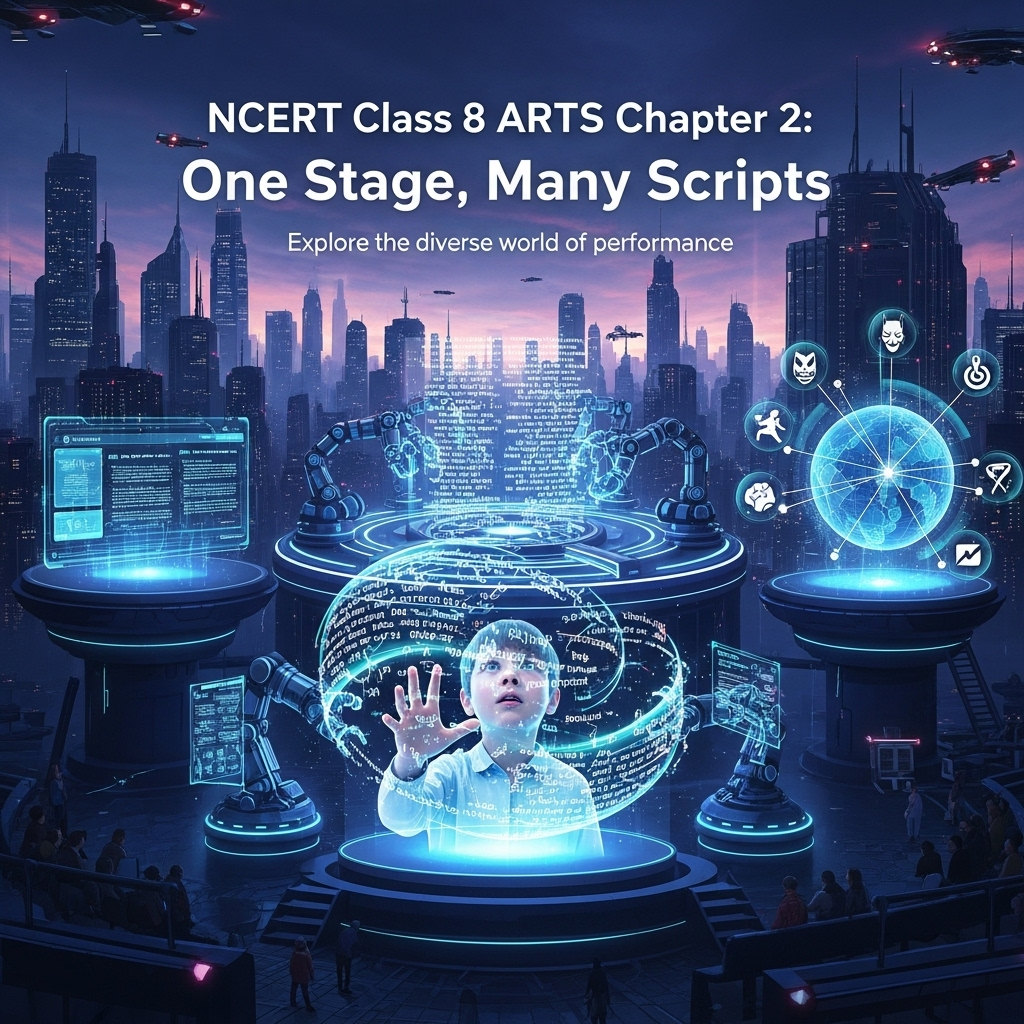Complete Solutions and Summary of One Stage, Many Scripts – NCERT Class 8, Arts, Chapter 2 – Summary, Questions, Answers, Extra Questions
Detailed summary and explanation of Chapter 2 ‘One Stage, Many Scripts’ with all question answers, extra questions, and solutions from NCERT Class VIII, Arts (Kriti).
Updated: 2 months ago

One Stage, Many Scripts
Chapter 2: Theater
Complete Study Guide with Interactive Learning
Chapter Overview
What You'll Learn
Importance of Scripts
Scripts are fundamental to performances; writing aids clarity, creativity, sharing, memory, and records for future generations.
Types of Scripts
Explore ancient Indian classifications like Daśha Rūpaka and modern equivalents such as one-act, two-act, and adapted scripts.
Genres Overview
Genres categorize writing by style and content, including tragedy, comedy, fantasy, and more, with over 300 documented.
Activities and Playwrights
Practical activities for scripting styles and genres; learn about playwrights like Kalidasa, Bharatendu Harishchandra.
Historical Context
This chapter explores scripts in theater, drawing from ancient Indian texts like Nāṭyaśhāstra, which classifies drama as drushya kavya. It compares ancient forms like Nataka and Prakarana with modern structures, highlighting evolution from Sanskrit poets to 19th-century playwrights.
Key Highlights
Scripts tie communication; genres provide frameworks for understanding; activities encourage creative writing in various styles like dialogue or musical scripts.
Comprehensive Chapter Summary
1. Importance of Scripts
Scripts are essential for performances. Writing develops ideas, brings clarity, fosters creativity, enables sharing, aids memory, and serves as records.
2. Scripts for Stage and Ancient India
Play Scripts
Designed for stage, film, or TV; vary in structure and purpose, reflecting human experiences.
Ancient Classifications
Termed rupa/rupaka or drushya kavya; combined dialogue and poetry; Nāṭyaśhāstra lists 10 types like Nataka.
Comparison with Modern
Ancient forms like Bhana (one-act) compare to modern one-act plays; adapted scripts from pre-existing materials.
3. Activity 2.1: Script Your Style
Styles
Dialogue, narrative, mime, musical scripts on a common topic; discuss style's impact on content and audience.
First Script
Samavakara by Brahma on Amrita Manthana, depicted in global icons like Suvarnabhumi Airport.
4. Genres
Popular Genres
Tragedy, comedy, melodrama, historical drama, musical, mystery, experimental, fantasy, docudrama.
5. Necessity of Genres
Benefits
Framework for interpretation; organization in libraries; avoids misinterpretation.
Genres in Other Arts
Music/dance: classical, folk; Visual arts: portrait, landscape.
6. Playwrights and Activity 2.2
Playwrights like Bharatendu Harishchandra ('Andher Nagri') and T.P. Kailasam. Activity: Categorize paragraphs into genres.
Key Concepts and Definitions
Script
Written work for performance on stage, film, or TV.
Genre
Category of art characterized by distinctive features in style and content.
Daśha Rūpaka
10 types of drama from Nāṭyaśhāstra, e.g., Nataka (5-10 acts).
Playwright
Writer of plays, e.g., Kalidasa, Bharatendu Harishchandra.
Tragedy
Focus on serious themes, protagonist's downfall.
Comedy
Humorous dialogues, happy ending.
Important Facts and Figures
Questions and Answers from Chapter
Short Questions
Q1. What is the most fundamental aspect of any performance?
Q2. Name one benefit of writing scripts.
Q3. What term did ancient Indian thinkers use for drama?
Q4. How many acts does Nataka have?
Q5. What is Prahasana based on?
Q6. What is the common topic in Activity 2.1?
Q7. What is the first written script according to Nāṭyaśhāstra?
Q8. Define genre.
Q9. Name one genre in music.
Q10. Who is known as the father of modern Hindi literature?
Q11. What is the title of Bharatendu's popular play?
Q12. What is T.P. Kailasam's title?
Q13. What genre is 'The Curious Case of the Vanishing Vada Pav'?
Q14. What is one Circle Time question?
Q15. What must you plan in a story?
Medium Questions
Q1. Explain why writing is important for developing ideas.
Q2. Describe play scripts in ancient India.
Q3. Compare Nataka with modern one-act plays.
Q4. What is Activity 2.1 about?
Q5. What is the significance of the first script?
Q6. Define tragedy genre.
Q7. Why is genre necessary?
Q8. Name genres in visual arts.
Q9. Who is Bharatendu Harishchandra?
Q10. Describe Activity 2.2.
Q11. What is fantasy genre?
Q12. Explain tragicomedy.
Q13. What is a playwright?
Q14. List Circle Time questions.
Q15. What to remember from previous grades?
Long Questions
Q1. Discuss the benefits of writing scripts in detail.
Q2. Explain play scripts in ancient India and their comparison with modern types.
Q3. Describe Activity 2.1 and its extensions.
Q4. What is the 'Do You Know' fact about the first script?
Q5. List and explain popular genres.
Q6. Why categorize works into genres?
Q7. Discuss genres in music, dance, and visual arts.
Q8. Describe the playwrights mentioned.
Q9. Explain Activity 2.2 with examples.
Q10. How to start writing in genres?
Q11. List Circle Time discussions.
Q12. What to remember for story/scripts?
Q13. Describe the assessment criteria.
Q14. Explain adapted scripts.
Q15. Discuss experimental genre.
Interactive Knowledge Quiz
Test your understanding of One Stage, Many Scripts
Quick Revision Notes
Script Benefits
- Clarity
- Creativity
- Sharing
Ancient Types
- Nataka
- Prakarana
- Bhana
Genres
- Tragedy
- Comedy
- Fantasy
Playwrights
- Kalidasa
- Bharatendu
- Kailasam
Exam Strategy Tips
- Compare ancient/modern
- Explain genres
- Describe activities
- Use examples
- Recall playwrights

Group Discussions
No forum posts available.
Easily Share with Your Tribe


